Displaying items by tag: Sgrech
Pwllheli Sailing Club Honours ISORA Mainstay Richard Tudor With Lifetime Contribution Award
A Welsh sailor with a longtime connection to offshore racing in the Irish Sea has been recognised by his home club with a lifetime contribution award.
Richard Tudor was presented with the accolade recently at a special function hosted by Pwllheli Sailing Club, which has posted a glowing tribute on its website.
A fixture on the ISORA calendar, most recently in the J125, Jackknife — and a former champion in the J109, Sgrech, too — Richard has been a part of Pwllheli’s club since its first clubhouse, after a childhood growing his love of the water under the tutelage of Gwyndaf Hughes.
Sailing also runs in the family, with his father Huw serving as Pwllheli’s commodore for a time and his brothers Andrew and Stephen also keen helmsmen.
Richard sailed his first ISORA in 1976, and his first Fastnet Race in 1977 — the beginnings of a decades-long connection with Ireland’s offshore sailing scene that continues to this day. Pwllheli Sailing Club has much more HERE.
ISORA Champions 'Sgrech' Retain Title in Final Race to Dun Laoghaire
#isora – Under not ideal weather and sea conditions yesterday's final ISORA race of 2013 was a battle of gargantuan proportions between the Series leader "Ruth" and close second "Sgrech". The two J109's, with "Sgrech" only giving 43 seconds in the expected 12 hour race "Ruth" writes ISORA chairman, Peter Ryan.
After a long season with many boats having races and sailed thousands of miles. With some boats with gear problems and others with crew fatigue after three consecutive weekends of offshore racing, only 13 boats out of an entry list of 22 came to the start line in Pwllheli. The PSC starter Richard Tudor sent the fleet of on a direct course from the start to the finish in Dun Laoghaire.
The weather forecast appeared to be very manageable with the winds of maximum 25 knots, north west backing south west over the day. Unfortunately the north west wind had been blowing strong for all the previous day producing overall conditions at Bardsey that were not pleasant. The first leg to Tudwals was a tight reach. After the warning signal "Sgrech" and "Ruth" commenced manouvers to get the better start. The two boats headed off in front of the fleet within a boat length of each other towards Tusdal's sound.
In Tudwal's sound more tussles arose between the tow boats in the form of a luffing match. This facilitate "Pipedreamer 6", "Mojito" and "Lula Belle" to pass them into the lead. Sea condition past Tudwal's sound warned of what was going to be met at Bardsey. It was a beat to Bardsey. While most of the fleet chose to go through the sound with the north going tide some boats including "Sarnia" ventured outside the island. The five lead boats arrived at Bardsey close together with "Ruth" and "Sgrech" exchanging tacks.
Conditions at Bardsey Sound were "pretty bad"!!!!. Huge and breaking seas met those who ventured through. "Sgrech" recorded a ground speed of 14.2k at one stage. "Windshift" suffered some slight gear damage with the pounding and retired. At the same time the life raft on "Sgrech" broke its fixings and was heading off the stern before the crew managed to retrieve it. "Poppy of Brighton" had retired earlier.
Exiting Bardsey "Ruth" and "Sgrech" were still within boats lengths of each other and leading the fleet with "Mojito" close behind and headed off north on a beat in the north going tide. The wind was still north west. Over the following few hours, the backing wind lifted the boats on the north leg of the beat to arrive north of the Bailey lighthouse. At all time "Ruth" and "Sgrech" were within 100m of each other with the boast being side by side "Ruth" being to weather. Felloe J109 "Mojito" was close behind.
It was only just approaching the Kish Light that "Sgrech" regained the advantage and set the scene of the tacking duel between the two boats across Dublin Bay to the finish at Dun Laoghaire Pier heads. "Sgrech" held the lead and finished just 1 minute 50 seconds ahead of "Ruth". "Mojito" finished approximately 10 minutes behind the leaders to give the J109's a 1st, 2nd and 3rd place overall and Class 1. "Sarnia", the oldest and lowest rated boat in the fleet took Class 2 and Silver Class Overall with "Lula Belle" taking 2nd Class 2 and "Yahtzee" taking 3rd Class 2 and 2nd Silver Class while Sigma 33 "Polished Manx" took 3rd Silver Class.
The result of the gargantuan battle between "Ruth" and "Sgrech" was that "Sgrech" retained the ISORA lynx metmAsts Offshore Series 2013 champion status, ahead of "Ruth". "Polished Manx" is the ISORA lynx metmAsts Offshore Silver Series 2013 champion. Full details are below.
The usual "dignified" end of series party took place in the NYC immediately after the race.
The progress of the race was recorded using the PredictWind tracker but some boats had technical problems. It can be viewed on the iPhone or smartphone app or on the website at http://forecast.predictwind.com/tracking/race/ISORA It is hoped to make the use of this tracker as mandatory for next years races however this will be discussed at the ISORA AGM in the NYC on the 16th November.
The prize giving will take place at the ISORA annual dinner to be held in the NYC on the 16th November. To avoid disappointment, it is vital that places are booked early with the club.
It was a fitting and exciting end to a very success offshore series where, with the possible exception of yesterday's race, all the races were sailed in great racing conditions. It is hoped that this close racing will attract new boats to enter and race "outside of the Bay".
Tudor's ISORA Win Completes 2012 Offshore Season
#isora – Having being runner up for the past two seasons the weekend winner of the 2012 ISORA Championship Sgrech is no stranger to the Irish Sea, her skipper Stephen Tudor and crew are a hardened offshore racing team from Pwlhelli in North Wales who have many years experience of Irish offshore campaigns for over 40 years.
Sgrech is a 2003 version J109. She was purchased in November 2010 by Hugh Williams, Philip Yapp and Tudor and replaced the team's J92 in which they achieved a very wet second overall in the 2010 ISORA series.
The team also achieved a second overall in Sgrech in 2011 again being beaten by Skerries Raging Bull.
Skipper Stephen Tudor has not yet been successful in persuading his brother, Richard, to join the crew. Richard skippered two circumnavigations in the Chay Blyth's Global Challenges and has provided considerable assistance in particular with Sgrech's preparation.
The 2012 Sgrech crew this year included the three co-owners and Stephen's son Thomas, one of many third generation ISORA competitors.
ISORA Chairman Peter Ryan who was on board Sgrech for the RORC Lyver Trophy race win in 2011 from Holyhead to Howth has also been on board this year to campaign for the ISORA series and June's Round Ireland Race.
Other crew members include RNLI member and veteran Round Ireland sailor Arfon Jones, Australian Andrew Rosewarne and Sarah Pemberton who sailed extensively with Andrew Hall.
The Tudor association with ISORA goes back to the 1970's when we raced with their father (Huw Tudor) on a Golden Shamrock, Gwobr Aur, at a time before DECCA or other navigation aids.
At that time there were regular ISORA fleets of about 40 which I think peaked at about 70. Stephen's first race was to Dun Laoghaire in 1976 (aged 16).
The Tudor's then campaigned a Contention 33, Panache and after that Greased Lightning. Richard and Huw went on to sail Corwynt Cymru III (Winner Class1 Cork Week 1992).
Corwynt Cymru was later renamed and is now known as Raging Bull, the 2011 champion that was wrecked in gales last May.































































